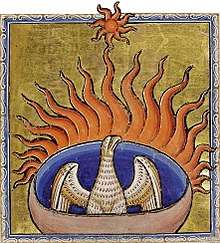Phoenix (mythology)
In Ancient Greek folklore, a phoenix (/ˈfiːnɪks/; Ancient Greek: φοῖνιξ, phoînix) is a long-lived bird that cyclically regenerates or is otherwise born again. Associated with the sun, a phoenix obtains new life by arising from the ashes of its predecessor. Some legends say it dies in a show of flames and combustion, others that it simply dies and decomposes before being born again.[1] Most accounts say that it lived for 500 years before rebirth.[2] Herodotus, Lucan, Pliny the Elder, Pope Clement I, Lactantius, Ovid, and Isidore of Seville are among those who have contributed to the retelling and transmission of the phoenix motif. The phoenix symbolized renewal in general, as well as entities and concepts such as the Sun, time, the Roman Empire, Christ, Mary, and virginity.[3]


Etymology
The modern phoenix comes from Latin phoenīx via Old English. The Latin word comes from Greek φοῖνιξ phoinīx.[4] The Greek word is first attested in the Mycenaean Greek po-ni-ke, which probably meant 'griffin', though it might have meant 'palm tree'. That word is probably a borrowing from a West Semitic word for madder, a red dye made from Rubia tinctorum. The word Phoenician appears to be from the same root, meaning 'those who work with red dyes'. So phoenix may mean 'the Phoenician bird' or 'the purplish-red bird'.[5]
The spellings phœnix and phenix are rare nowadays.
Egyptian origin hypothesis and the Bennu
Classical discourse on the subject of the phoenix points to a potential origin of the phoenix in Ancient Egypt. Herodotus, writing in the 5th century BC, gives a somewhat skeptical account of the phoenix. For example:
[The Egyptians] have also another sacred bird called the phoenix which I myself have never seen, except in pictures. Indeed it is a great rarity, even in Egypt, only coming there (according to the accounts of the people of Heliopolis) once in five hundred years, when the old phoenix dies. Its size and appearance, if it is like the pictures, are as follow:– The plumage is partly red, partly golden, while the general make and size are almost exactly that of the eagle. They tell a story of what this bird does, which does not seem to me to be credible: that he comes all the way from Arabia, and brings the parent bird, all plastered over with myrrh, to the temple of the Sun, and there buries the body. In order to bring him, they say, he first forms a ball of myrrh as big as he finds that he can carry; then he hollows out the ball and puts his parent inside, after which he covers over the opening with fresh myrrh, and the ball is then of exactly the same weight as at first; so he brings it to Egypt, plastered over as I have said, and deposits it in the temple of the Sun. Such is the story they tell of the doings of this bird.[6]
In the 19th century, scholastic suspicions appeared to be confirmed by the discovery that Egyptians in Heliopolis had venerated the Bennu, a solar bird similar in some respects to the Greek phoenix. However, the Egyptian sources regarding the bennu are often problematic and open to a variety of interpretations. Some of these sources may have actually been influenced by Greek notions of the phoenix, rather than the other way around.[7]
Appearance
The phoenix is sometimes pictured in ancient and medieval literature and medieval art as endowed with a halo, which emphasizes the bird's connection with the Sun.[8] In the oldest images of phoenixes on record these nimbuses often have seven rays, like Helios (the Greek personification of the Sun).[9] Pliny the Elder[10] also describes the bird as having a crest of feathers on its head,[11][8] and Ezekiel the Dramatist compared it to a rooster.[12]
Although the phoenix was generally believed to be colorful and vibrant, sources provide no clear consensus about its coloration. Tacitus says that its color made it stand out from all other birds.[13] Some said that the bird had peacock-like coloring, and Herodotus's claim of the Phoenix being red and yellow is popular in many versions of the story on record.[14] Ezekiel the Dramatist declared that the phoenix had red legs and striking yellow eyes,[12] but Lactantius said that its eyes were blue like sapphires[15] and that its legs were covered in yellow-gold scales with rose-colored talons.[16]
Herodotus, Pliny, Solinus, and Philostratus describe the phoenix as similar in size to an eagle,[17] but Lactantius and Ezekiel the Dramatist both claim that the phoenix was larger, with Lactantius declaring that it was even larger than an ostrich.[18]
In Gnostic texts
Ideas taking the phoenix into consideration presented themselves in the Gnostic manuscript On the Origin of the World from the Nag Hammadi Library collection:
Thus when Sophia Zoe saw that the rulers of darkness had laid a curse upon her counterparts, she was indignant. And coming out of the first heaven with full power, she chased those rulers out of their heavens and cast them into the sinful world, so that there they should dwell, in the form of evil spirits upon the earth. [...], so that in their world it might pass the thousand years in paradise - a soul-endowed living creature called "phoenix". It kills itself and brings itself back to life as a witness to the judgement against them, for they did wrong to Adam and his race, unto the consummation of the age. There are [...] three men, and also his posterities, unto the consummation of the world: the spirit-endowed of eternity, and the soul-endowed, and the earthly. Likewise, there are three phoenixes in paradise - the first is immortal, the second lives 1,000 years; as for the third, it is written in the sacred book that it is consumed. So, too, there are three baptisms - the first is spiritual, the second is by fire, the third is by water. Just as the phoenix appears as a witness concerning the angels, so the case of the water hydri in Egypt, which has been a witness to those going down into the baptism of a true man. The two bulls in Egypt posses a mystery, the Sun and the Moon, being a witness to Sabaoth: namely, that over them Sophia received the universe; from the day that she made the Sun and Moon, she put a seal upon her heaven, unto eternity. And the worm that has been born out of the phoenix is a human being as well. It is written concerning it, "the just man will blossom like a phoenix". And the phoenix first appears in a living state, and dies, and rises again, being a sign of what has become apparent at the consummation of the age.[19]
In later European culture


The Old English Exeter Book contains an anonymous 677-line 9th-century alliterative poem consisting of a paraphrase and abbreviation of Lactantius, followed by an explication of the Phoenix as an allegory for the resurrection of Christ.[20]
Þisses fugles gecynd fela gelices |
This bird's nature is much like |
| —In the original Old English[21] | —In Modern English translation (1842)[21] |
Dante refers to the phoenix in Inferno Canto XXIV:
Così per li gran savi si confessa |
Even thus by the great sages 'tis confessed |
| —In the original Italian | —In English translation |
In the play Henry VIII by William Shakespeare and John Fletcher, Archbishop Cranmer says in Act V, Scene v in reference to Elizabeth (who was to become Queen Elizabeth I):
...Nor shall this peace sleep with her; but as when
The bird of wonder dies, the maiden phoenix,
Her ashes new create another heir
As great in admiration as herself;
So shall she leave her blessedness to one,
When heaven shall call her from this cloud of darkness,
Who from the sacred ashes of her honour
Shall star-like rise as great in fame as she was,
And so stand fix'd...
Phoenixes are present and relatively common in European heraldry. They most often appear as crests, and more rarely as charges. The heraldic phoenix is depicted as the head, chest and wings of an eagle rising from a fire; the entire creature is never depicted.[22]
Analogues
Scholars have observed analogues to the phoenix in a variety of cultures. These analogues include the Hindu garuda (गरुड) and bherunda (भेरुण्ड), the Russian firebird, the Persian simorgh (سیمرغ), the Georgian paskunji, the Arabian anqa (عنقاء), the Turkic Konrul, also called Zümrüdü Anka ("emerald anqa"), the Tibetan Me byi karmo, the Chinese Fenghuang (鳳凰) and zhu que (朱雀), and the Japanese hō-ō (鳳凰).[23]
See also
- List of phoenixes in popular culture
- Chalkydri
- Chol (Bible), a Hebrew word sometimes glossed as phoenix
Notes
- Van der Broek 1972, p. 146.
- Van der Broek 1972, pp. 67–70.
- Van der Broek 1972, p. 9.
- Barnhart 1995, p. 564.
- Van der Broek 1972, p. 62–66.
- Herodotus, The Histories (1858 translation), Book II Trans. G. Rawlinson (1858)
- Van der Broek 1972, p. 14–25.
- Van der Broek 1972, p. 233.
- Van der Broek 1972, pp. 246–247.
- Ancient Magic and the Supernatural in the Modern Visual and Performing Arts, edited by Filippo Carlà-Uhink, Irene Berti, 2016, page 172
- Pliny the Elder, Natural History, 10.2
- Van der Broek 1972, p. 257.
- Van der Broek 1972, p. 253.
- Van der Broek 1972, p. 259.
- Van der Broek 1972, p. 256.
- Van der Broek 1972, pp. 257–258.
- Van der Broek 1972, p. 251.
- Van der Broek 1972, p. 252.
- James M. Robinson (1988). The Nag Hammadi Library. pp. 291-292. HarperCollins Publishers.
- Blake 1964, p. 1.
- Thorpe, Benjamin; Corson, Hiram (1842). "Codex exoniensis. A collection of Anglo-Saxon poetry, from a manuscript in the library of the dean and chapter of Exeter". p. 244. Retrieved 9 December 2018.
- Arthur Fox-Davies, A Complete Guide to Heraldry, T.C. and E.C. Jack, London, 1909, 240, https://archive.org/details/completeguidetoh00foxduoft.
- Garry & El-Shamy 2005, pp. 84–87.
References
- Barnhart, Robert K (1995), The Barnhart Concise Dictionary of Etymology, HarperCollins, ISBN 0-06-270084-7.
- Blake, N F (1964), The Phoenix, Manchester: Manchester U Press.
- Garry, Jane; El-Shamy, Hasan (2005), Archetypes and Motifs in Folklore and Literature, ME Sharpe, ISBN 978-0-76561260-1.
- Thompson, Stith. 2001. Motif-Index of Folk-Literature: A Classification of Narrative Elements in Folk Tales, Ballads, Myths, Fables, Mediaeval Romances, Exempla, Fabliaux, Jest-Books, and Local Legends, Volume 1; Volume 6. Indiana University Press. 9780253340894
- Van der Broek, R (1972), The Myth of the Phoenix, Seeger, I trans, EJ Brill.
